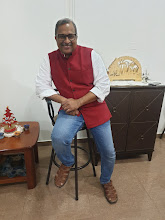I see so much being written about the city I grew up in as it celebrates 375 years of it's coming into existence. The reason I write this is also because of the fact that I keep reading articles on Madras by people 30 and below who write about Saarang and not Mardi Gras or from people who were 50 and above who write about the time when the Adyar river was still used as a means of transportation. The other reason is the fast narrowing gap on the difference in the number of years I spent outside Madras and in it. As though, prophesied, I left the city of Madras the year it changed its identity to Chennai, circa 1996, after having spent 24 years in the city. I dread the time I will turn 48 because that's when I have to end up equally sharing the period of my domicile status with a couple of other Middle Eastern cities.
Here is a take on how nostalgia can trigger you, courtesy wikepedia.
‘The scientific literature on nostalgia is quite thin, but a few studies have attempted to pin down its essence and causes. Smell and touch are strong evokers of nostalgia due to the processing of these stimuli first passing through the amygdala, the emotional seat of the brain. These recollections of our past are usually important events, people we care about, and places where we have spent time. Music and weather can also be strong triggers of nostalgia.’
So here I am trying to use sound and smell to bring to you the nostalgic journey of a die-hard Madrasi.
You can go to bed in a neighborhood called Border Thottam, where the lullaby would comprise of the sound of the choicest words from the original Madras Tamil literature the kind of o..., kasmaalam, kaidhey and the likes, addressed by a rickshawkaaran high on a round of sarayam, the local brew or the potlam the local potent smoke, followed by an interlude coming from vessels being thrown around and conclude with the so far patient wife thrashing the day lights out of him and then the thuds of thumping her heart, not as a sign of victory but as an act of cursing her fate . In the very same city in another part you can wake up to the strains of suprabadham making its way through your windows. Or a song from an Illayaraja number playing in your next door tea shop. The strains of 'sa re ga maa' from the paatu class or the 'thyyum thatha thayyum thaha' from a dance class in the neighborhood. The call of the old newspaperman or the kaikarikaran, the mobile vegetable vendor breaking the afternoon silence with his call for business which actually sounds like it follows all fundamentals of Carnatic music or the late night arrival of the cotton candy (sonpapadi) man ringing a bell. Or simply close your eyes and stand in T Nagar and hear the din, for some, but music for others like me, or the call to business in the zambazaar fish market. The kaaapi kaapiy call as the Madras Mail pulls into Arakonam junction and after you alight from the train the ‘side, side’ call of the coolies or the ‘meter mela 10 rubaa savaari’ negotiations with the omni present autokaaran who you can hear before you can actually see them. The mother of all sounds of Madras ironically is the music associated with the final rituals en route ones heavenly abode. I have always wondered that the rhythm associated with the ‘Saavu mollam’ could actually bring back the dead.
In a recent tribute song called the Madras song by Murugappa Group and The Hindu as part of the Madras day celebration the lyrics went thus 'Vasanai thaan enga GPS' literally translated as we use our olfactory enabled GPS. I know it is debatable and taboo to talk about the scents of Madras. However I intend venturing out on it. Sitting in a window seat of an erstwhile PTC bus, try and do a Parrys to the South of Madras trip, the fragrance in the air to begin with is jasmine from the flower bazaar which gets a little adulterated as we pass the Napiers Bridge this turns to a musky smell of salty air from the Bay of Bengal and then we smell the strong aromatic balm we associate with colds and coughs as we cross the Amrutanjan factory on Luz Church Road. On the way we cross a shrimp processing unit followed by a cookie (more commonly known as the butter biscuit) factory. This gives you a feeling that you have had a seafood meal followed by the choicest of cookies on cream as deserts. Small joys I say. As the bus passes a funeral procession, this is when the smell and the sound of Chennai get juxtaposed. You smell the rose petals and tap your feet to the rhythm of the saavu mollam. So if you ever were to be kidnapped in the city blindfolded you exactly know the route you are taken.
The landscape of the city may change over the years, the memories that one has from the senses above are the ones that are retained for decades. Madras might not look the same anymore but it still does smell and sound the same for me always though with some minor variations.
Happy Madras Day to all.
Friday, August 22, 2014
Subscribe to:
Post Comments (Atom)

1 comment:
Thoroughly enjoyed!Particularly the locations you have selected for the olfactory tour were perfect.Thought u will head straight to Besant nagar after crossing Napier bridge and Marina but surprisingly took a right turn to Mylapore,a twist like a seasoned politician...A fitting tribute to Madras on the day when it started to take shape 375 years ago..
Post a Comment